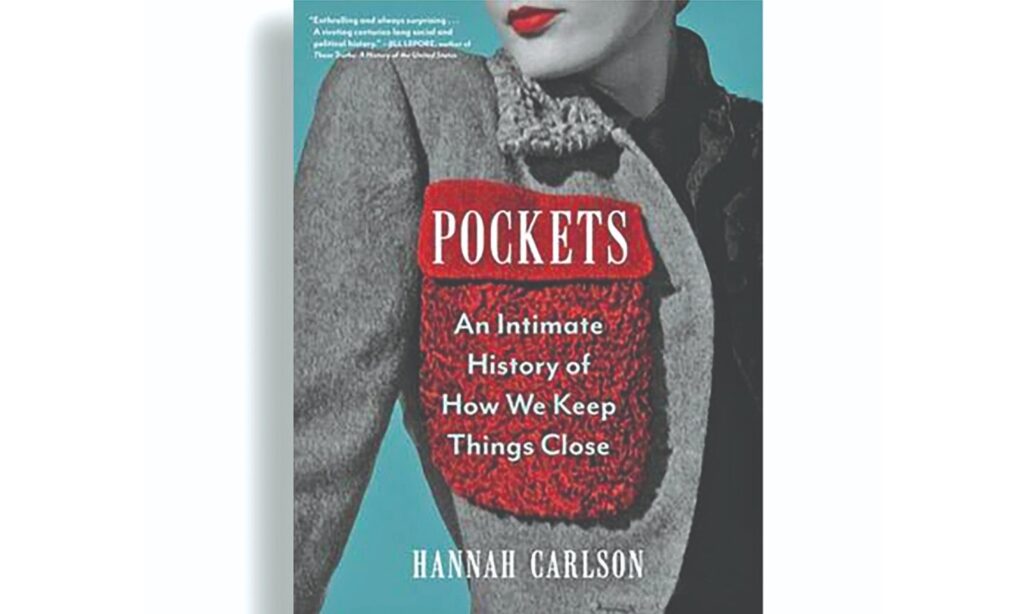
The beginning of wisdom about body language is the universal validity of the nostrum: keep your hands out of your pockets. The perdurable infamy associated with enjoying the mere power of containment besom pockets offer and the contradictory attitudes attributed to anyone consummating the mute repose of putting their hands in them shows we don’t always know why someone offends us—even if we think it has to do with what they do with their hands in our company. Hannah Carlson’s Pockets: An Intimate History of How we Keeps Things Close digs deeply, and eagerly probes for clues to the enigma of the pocket among the miscellany of fob watches, wallets, mobile phones, cosmetics, guns, and keys only—I think—to come up empty.
Whether you’re the Duchess of Sussex “pioneering a new, relaxed, tactile branch of monarchy” or the governor of Tokyo keeping warm on a podium, hands in the pockets are a no-no. On the one hand it can be read as anxiety, diffidence, or deceptiveness; an avoidance-oriented coping behaviour. On the other hand, it can be—confusingly—seen as betraying disrespect, self-absorption, or aloofness; an approach-oriented, passive aggressive attitude to adopt in a social situation. It seems you can just as easily convey contempt or timidity merely by placing your hands into the typical bag or envelope like containers fastened on to an article of clothing. And this has been so since our clothes first sported pockets. There’s more to the social significance of the pocket than who uses it and what they use it for, and this is why a class analysis of pocket inequality, or a feminist analysis of the gender pocket gap, comes up empty. The cult of the pocket is a big tent party, and its adherents and renegades much like the content of peoples’ pockets comprise an unanalysable motley. There are as many sorts of pocket enjoyers as there are pocket sized objects.
Packing Heat & Pocket Meat
The first pocket panic dates back to the early sixteenth century invention of guns amenable to concealed carrying. The French monarch Henry III took offence at the puffiness of commoners’ pockets, stuffed to bursting with “bombast” that made men too big for their breeches, as much as their capacity to conceal a deadly firearm. In 1564 he banned big pockets and set a limit to the amount of padding men could endow on their trunk hoses. Violators were punished by parading them in their trousers torn up to expose the rags, sawdust, and horsehair puffing them up beyond their station. “Pocket dags” that could be “carried privily” (Carlson) and gave their bearer a decisive advantage over a more physically, and politically, powerful opponent attracted the attention and censure of the British monarchy in 1579.
Now that metal detectors, scanners, and invasive frisking have rendered others’ pockets less threatening it is their illocutionary potential that exercises the caution of commentators like etiquette expert William Hanson. But even as early as the late nineteenth century people were aware that placing one’s hands in one’s pockets was a speech act. It demonstrated one had rejected “the imperative to be polite” and didn’t care if people thought one was a “vulgar boy” fondling oneself under the sartorial scandal. The great American poet Walt Whitman, avowed self-fondler and author of Song of Myself, definitely cottoned on to that connotation of the gesture and used it as vehicle for a provocative self-presentation in his author portrait. “Rather than stand upright, Whitman tips hat, eyebrow, and hips at a similar rakish angle, letting his weight fall unevenly,” leting one hand loose in its pocket while setting the other akimbo (Carlson). This provocation succeeded beyond Whitman’s hopes and garnered him a “great fire of criticism” of the literary and non-literary kind. One reviewer called the man and the book Leaves of Grass equally “rough, uncouth,” and “vulgar” (Carlson).

Sporting Lint
Even the sartorially challenged among us have not failed to notice men’s clothing tends to have pockets by default. By contrast, women looking for pocket-friendly apparel need to look hard and often make the hard choice of prioritising either convenience or style. The history of the pocket undeniably has its sexist actors and stories. But it is unlikely that parochial nineteenth century tailors worried women might carry guns and tobacco in their pockets started a conspiracy to deprive them of this singular affordance. Parallelly, consider how the fact that the guitar has been culturally coded as masculine with women players historically overlooked and discriminated against doesn’t go any way towards showing that guitar inequality or gender guitar gap is a conspiracy of luthiers. The battle of the sexes is dispositional and ideological, comprised of natural and cultural differences. On Carlson’s analytical perspective almost any manufactured consumer good usable by both genders but preferentially used more by men can be cited as a product and evidence of male privilege. Shaving cream is only advertised to men though obviously women can use it. Is this male privilege or just savvy manufacturers and marketers knowing who is likely to demand and use shaving cream?
Carlson gives the reader a delightful survey of the changing fashion trends that dictated the fate of the pocket in women’s clothing. The dialectic traced here from Diana Vreeland’s 1930 proposal to run an entire issue of Harper’s Bazar exploring the possibilities of the pocket to liberate women from the handbag to Christian Dior’s 1950 gauntlet that women have pockets for decoration fails to settle a foundational issue. Do women want pockets? Do they want pockets more than they want purses and handbags? Simply, the tack taken by Carlson fails to acknowledge the role of consumer demand in deciding whether or not pockets go on various items of women’s apparel. Men are no naifs when it comes to the fashion faux pas of bulging pockets, and the recurring putsch on behalf of the man purse suggests they too face the social pressure to choose between comfort or style. They must either carry all the knickknacks they need pocket bulging be damned or carry a female coded accessory that can contain it all except the resultant negative stereotyping. Of course, they might opt for the many-pocketed splendour that is the cargo pant if they don’t mind being judged as chavs or weirdos into extreme music.
The growing availability of a wide variety of women’s clothing with pockets alongside the unaging glamour of the women’s handbag, which now must serve as ornament and luggage—reconciling vestigial function with specular form—, indicates that clothiers and fashion houses are closer to the truth of what women want than women are themselves. They listen to women’s purchases over time rather than to what they say they want in magazine editorials. Perhaps a woman can have it all. Perhaps this is why she has pockets in her clothing as well as a nice, roomy, stylish handbag: to contain it all. Those seeking to find an answer to the riddle posed by the tension between the function and form of pockets in women’s [and men’s] clothing by interrogating the pocket gap discourse will only find pockets to be sporting lint.
REFERENCE
Hannah Carlson. (2023). Pockets: An Intimate History of How We Keep Things Close. Algonquin Books





